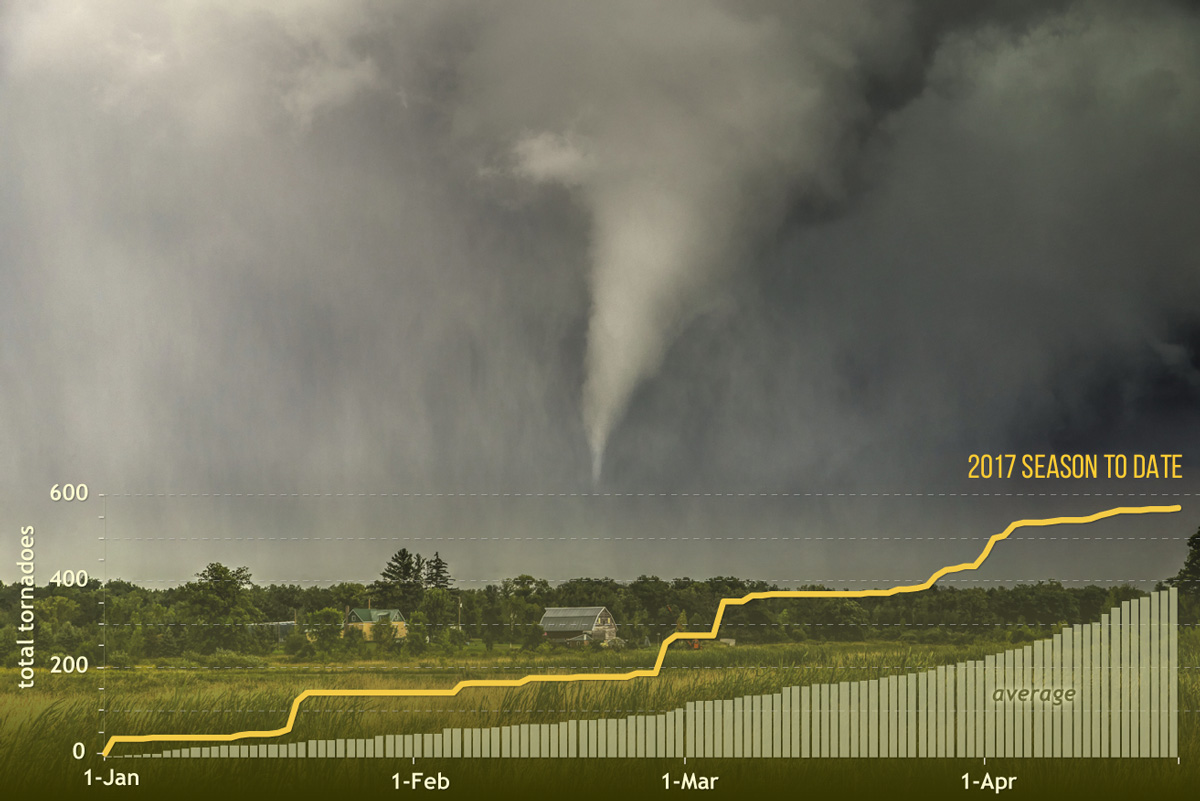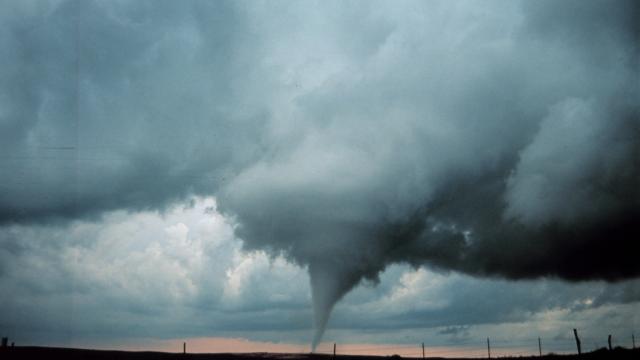As of mid April, at least 570 tornadoes have been reported in the United States this year. That’s nearly a hundred more than the typical tally for mid-spring. So what’s going on there, America?
Image: NOAA
As the NOAA notes in an agency release, the 2017 tornado season across the United States is off to an incredibly active start, at least compared to the last 25 years. So far, much of this tornadic activity has been focused across the Gulf Coast states, especially Georgia. This makes sense, seeing as tornadoes need moisture and an unstable atmosphere that allows air to rise easily. These conditions are largely absent elsewhere in the United States during the first few months of the year, but can persist year-round along the warm, moist Atlantic Gulf coast.

This graph shows the running tally of preliminary tornado counts in 2017 (gold line, through April 22) compared to the 2005-2015 average (beige bars). The data was provided by Patrick Marsh of NOAA’s Storm Prediction Center. (Image: NOAA)
As temperatures warm into the spring and summer, the conditions required to sustain severe weather shift north and westwards towards the Great Plains and Tornado Alley. The NOAA animation below illustrates this, showing the historic probability of all types of severe weather across the calendar year.
The 2017 US tornado season may be off to an intense start, but this early activity is no guarantee of what awaits Americans for the rest of the year. As Weather Company’s senior meteorologist Jon Erdman explained to Gizmodo, it all depends on the presence of a particular pattern in the jet stream — that narrow band of strong winds in the upper levels of the atmosphere that marks the boundary between air masses of different temperatures.
“Basically, the upper air jet stream, as it’s seen on a map, is taking a southwards plunge towards the the Gulf of Mexico, and it’s creating a kind of trough,” he said. “This is a weather pattern that’s very conducive for severe weather and tornadoes, and it’s the dominant pattern we’ve seen this year.”
When the jet stream is in this configuration, it delivers warm, moist air from the Gulf of Mexico into the interior of the United States.
“It’s a big contrast to recent years where we’ve had lower tornado counts,” Erdman said. “Instead of the jet stream diving southwards and streaming into the West as it’s doing this year, [during other years] it was the opposite, and with that type of pattern we don’t get as much severe weather.”
As to whether this early season uptick in tornadoes has any relationship to climate change, that’s also difficult to know. As the USGS noted in February of this year, spring was well ahead of schedule across much of the southern United States this year. Scientists with the US National Phenology Network said the warm weather that caused leaves to come out weeks ahead of schedule was likely the result of climate change. The relationship between climate change and other forms of severe weather is an area of active research.
To date, no link between climate change and tornadoes has been established. The leading expert in this area is Harold Brooks, a senior research scientist at the National Severe Storms Laboratory, where he studies severe thunderstorms and tornadoes. He has found that, in a warming climate, increased humidity and hotter air are likely to trigger more severe weather — but not necessarily tornadoes. In 2016, a study led by Brooks suggested that a recent rash of tornado clusters across the US could not be linked to a warming climate. “Either the recent increases are not due to a warming climate, or a warming climate has implications for tornado activity that we don’t understand,” wrote Brooks.
Indeed, we simply don’t know. At least not yet. Given all the weird stuff that’s going on with tornadoes these days, it’s fair to say it’s an area ripe for further investigation.
[NOAA]
